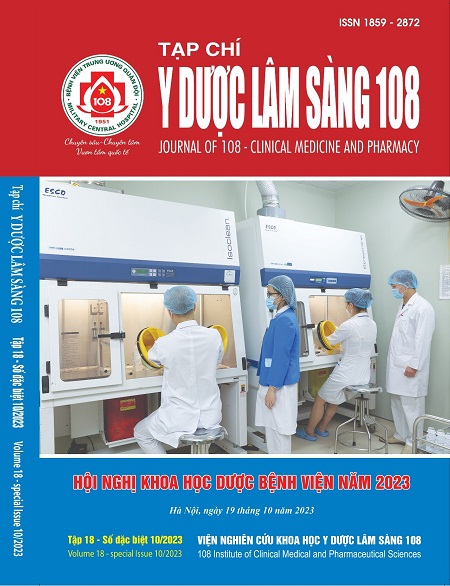Mối liên quan giữa nồng độ đáy vancomycin và kết quả điều trị viêm màng não phế cầu ở trẻ em
Main Article Content
Keywords
Tóm tắt
Vancomycin là kháng sinh đóng vai trò quan trọng trong điều trị viêm màng não phế cầu ở trẻ em. Tuy nhiên, việc nhanh chóng đạt đích nồng độ đáy của thuốc từ 10-15mg/L ngay từ những ngày đầu điều trị có thực sự mang lại kết quả điều trị tốt hơn hay không còn chưa rõ ràng. Mục tiêu: Nhận xét mối tương quan giữa nồng độ đáy vancomycin và kết quả điều trị viêm màng não do phế cầu tại Bệnh viện Nhi Trung ương. Đối tượng và phương pháp: Nghiên cứu hồi cứu, mô tả trên 37 bệnh nhi viêm màng não phế cầu, được theo dõi nồng độ vancomycin tại Trung tâm Bệnh Nhiệt đới, Bệnh viện Nhi Trung ương từ tháng 7/2020 đến tháng 7/2022. Kết quả: Nhóm đạt đích nồng độ đáy ngay lần đầu định lượng có tỷ lệ thất bại điều trị với vancomycin, tỷ lệ tử vong/di chứng thấp hơn các nhóm không đạt đích. Kết luận: Việc sớm đạt đích nồng độ đáy giúp cải thiện kết quả điều trị bằng vancomycin ở trẻ viêm màng não phế cầu.
Article Details
Các tài liệu tham khảo
2. Bệnh viện Nhi Trung ương (2020) Quy trình kỹ thuật theo dõi nồng độ vancomycin trong máu. QTKT.D.001.V1.0.
3. Viladrich PF, Gudiol F, Liñares J et al (1991) Evaluation of vancomycin for therapy of adult pneumococcal meningitis. Antimicrobial agents and chemotherapy 35(12): 2467-2472.
4. Wei WX, Qin XL, Cheng DH et al (2016) Retrospective analysis of vancomycin treatment outcomes in Chinese paediatric patients with suspected Gram-positive infection. 41(6): 650-656. doi: https://doi.org/10.1111/jcpt.12437.
5. Rodriguez CA, Atkinson R, Bitar W et al (2004) Tolerance to vancomycin in pneumococci: Detection with a molecular marker and assessment of clinical impact. The Journal of infectious diseases 190(8): 1481-1487.
6. McCullers JA, English BK, Novak R (2000) Isolation and characterization of vancomycin-tolerant Streptococcus pneumoniae from the cerebrospinal fluid of a patient who developed recrudescent meningitis. The Journal of infectious diseases. Jan 181(1): 369-373.
7. McKamy S, Hernandez E, Jahng M et al (2011) Incidence and risk factors influencing the development of vancomycin nephrotoxicity in children. The Journal of pediatrics. Mar 158(3): 422-6. doi:10.1016/j.jpeds.2010.08.019.
8. Kondo M, Nakagawa S, Orii S et al (2020) Association of Initial Trough Concentrations of Vancomycin with Outcomes in Pediatric Patients with Gram-Positive Bacterial Infection. Biological & pharmaceutical bulletin 43(10): 1463-1468. doi: 10.1248/bpb.b19-01003.
9. Yoo RN, Kim SH, Lee J (2017) Impact of initial vancomycin trough concentration on clinical and microbiological outcomes of methicillin-resistant staphylococcus aureus bacteremia in children. Journal of Korean medical science 32(1): 22-28.
10. Sridharan K, Al-Daylami A, Ajjawi R et al (2019) Vancomycin Use in a Paediatric Intensive Care Unit of a Tertiary Care Hospital. Paediatric drugs. Aug 21(4): 303-312. doi:10.1007/s40272-019-00343-9
11. Cao L, Li Z, Zhang P, Yong S (2022) Relationship between vancomycin trough serum concentrations and clinical outcomes in children: a systematic review and meta-analysis. Antimicrob Agents Chemother 66(8): 0013822. doi:10.1128/aac.00138-22
 ISSN: 1859 - 2872
ISSN: 1859 - 2872
